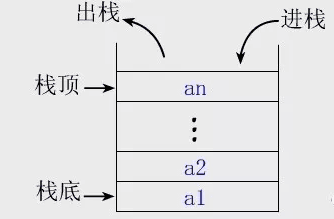线性表 - 栈和队列
线性表 - 栈和队列
提示
数组和链表都是线性存储结构的基础,栈和队列都是线性存储结构的应用。
知识点
栈 - LIFO
示意图

实现
- 使用数组实现的叫
静态栈 - 使用链表实现的叫
动态栈
队列 - FIFO
示意图

实现
- 使用数组实现的叫
静态队列 - 使用链表实现的叫
动态队列
JDK中实现
[ 《Java - Stack & Queue 源码解析》 ](/md/java/collection/java-collection- Queue&Stack.html)
栈和队列相关题目
用栈实现队列
232. Implement Queue using Stacks (Easy) 在新窗口打开
栈的顺序为后进先出,而队列的顺序为先进先出。使用两个栈实现队列,一个元素需要经过两个栈才能出队列,在经过第一个栈时元素顺序被反转,经过第二个栈时再次被反转,此时就是先进先出顺序。
class MyQueue {
private Stack<Integer> in = new Stack<>();
private Stack<Integer> out = new Stack<>();
public void push(int x) {
in.push(x);
}
public int pop() {
in2out();
return out.pop();
}
public int peek() {
in2out();
return out.peek();
}
private void in2out() {
if (out.isEmpty()) {
while (!in.isEmpty()) {
out.push(in.pop());
}
}
}
public boolean empty() {
return in.isEmpty() && out.isEmpty();
}
}
用队列实现栈
225. Implement Stack using Queues (Easy) 在新窗口打开
在将一个元素 x 插入队列时,为了维护原来的后进先出顺序,需要让 x 插入队列首部。而队列的默认插入顺序是队列尾部,因此在将 x 插入队列尾部之后,需要让除了 x 之外的所有元素出队列,再入队列。
class MyStack {
private Queue<Integer> queue;
public MyStack() {
queue = new LinkedList<>();
}
public void push(int x) {
queue.add(x);
int cnt = queue.size();
while (cnt-- > 1) {
queue.add(queue.poll());
}
}
public int pop() {
return queue.remove();
}
public int top() {
return queue.peek();
}
public boolean empty() {
return queue.isEmpty();
}
}
最小值栈
[ 155. Min Stack (Easy) 在新窗口打开 ](https://leetcode.com/problems/min- stack/description/)
class MinStack {
private Stack<Integer> dataStack;
private Stack<Integer> minStack;
private int min;
public MinStack() {
dataStack = new Stack<>();
minStack = new Stack<>();
min = Integer.MAX_VALUE;
}
public void push(int x) {
dataStack.add(x);
min = Math.min(min, x);
minStack.add(min);
}
public void pop() {
dataStack.pop();
minStack.pop();
min = minStack.isEmpty() ? Integer.MAX_VALUE : minStack.peek();
}
public int top() {
return dataStack.peek();
}
public int getMin() {
return minStack.peek();
}
}
对于实现最小值队列问题,可以先将队列使用栈来实现,然后就将问题转换为最小值栈,这个问题出现在 编程之美: 3.7。
用栈实现括号匹配
20. Valid Parentheses (Easy) 在新窗口打开
"()[]{}"
Output : true
public boolean isValid(String s) {
Stack<Character> stack = new Stack<>();
for (char c : s.toCharArray()) {
if (c == '(' || c == '{' || c == '[') {
stack.push(c);
} else {
if (stack.isEmpty()) {
return false;
}
char cStack = stack.pop();
boolean b1 = c == ')' && cStack != '(';
boolean b2 = c == ']' && cStack != '[';
boolean b3 = c == '}' && cStack != '{';
if (b1 || b2 || b3) {
return false;
}
}
}
return stack.isEmpty();
}
数组中元素与下一个比它大的元素之间的距离
739. Daily Temperatures (Medium) 在新窗口打开
Input: [73, 74, 75, 71, 69, 72, 76, 73]
Output: [1, 1, 4, 2, 1, 1, 0, 0]
在遍历数组时用栈把数组中的数存起来,如果当前遍历的数比栈顶元素来的大,说明栈顶元素的下一个比它大的数就是当前元素。
public int[] dailyTemperatures(int[] temperatures) {
int n = temperatures.length;
int[] dist = new int[n];
Stack<Integer> indexs = new Stack<>();
for (int curIndex = 0; curIndex < n; curIndex++) {
while (!indexs.isEmpty() && temperatures[curIndex] > temperatures[indexs.peek()]) {
int preIndex = indexs.pop();
dist[preIndex] = curIndex - preIndex;
}
indexs.add(curIndex);
}
return dist;
}
循环数组中比当前元素大的下一个元素
503. Next Greater Element II (Medium) 在新窗口打开
Input: [1,2,1]
Output: [2,-1,2]
Explanation: The first 1's next greater number is 2;
The number 2 can't find next greater number;
The second 1's next greater number needs to search circularly, which is also 2.
与 739. Daily Temperatures (Medium) 不同的是,数组是循环数组,并且最后要求的不是距离而是下一个元素。
public int[] nextGreaterElements(int[] nums) {
int n = nums.length;
int[] next = new int[n];
Arrays.fill(next, -1);
Stack<Integer> pre = new Stack<>();
for (int i = 0; i < n * 2; i++) {
int num = nums[i % n];
while (!pre.isEmpty() && nums[pre.peek()] < num) {
next[pre.pop()] = num;
}
if (i < n){
pre.push(i);
}
}
return next;
}
参考文章
https://www.cnblogs.com/QG-whz/p/5170418.html
https://www.cnblogs.com/QG-whz/p/5171123.html
